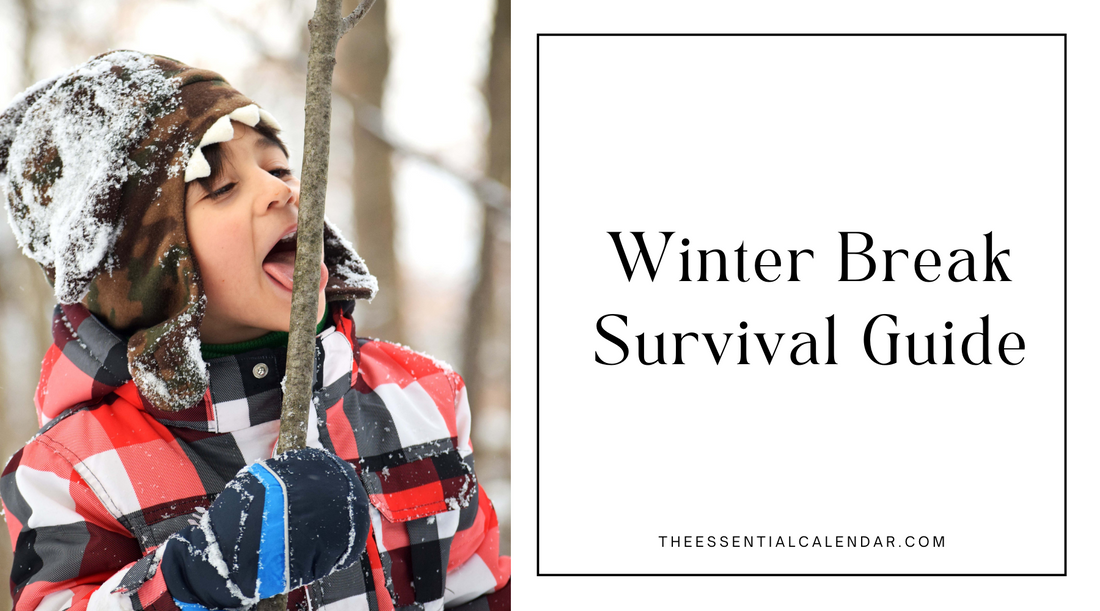
Your Winter Break Survival Guide: Ideas, Tips, and Tricks
Winter break is a magical time filled with opportunities to relax, reconnect, and recharge. But let's face it: keeping everyone entertained and engaged while maintaining your sanity can be a challenge! Whether you’re managing preschoolers’ endless energy or helping college students make the most of their time at home, here’s a survival guide packed with ideas for every age group.
For Every Age:
1. Collaborate on Activity Ideas:
Start by involving your kids in the planning process. Ask them to share what they’d like to do over the break. When I tried this recently with my own family, the top idea was a Mario Kart tournament bracket for everyone to join! It could be something just as simple, like a movie they want to watch together. Writing these suggestions on our circle sticky notes and placing them alongside your family calendar ensures their ideas are part of the plan—and actually happen!
2. Build a Pillow and Blanket Fort:
No matter how old your kids are, a blanket fort is always a hit. In our house, building one has become a winter break tradition, even with older kids. We kick off the break by making one and leave it set up in the playroom (or their bedrooms) the entire time. It creates a cozy, imaginative space where they can read, play, or just relax.
3. Host a Family Talent Show:
Bring everyone together for a fun evening of performances! Preschoolers can sing or dance, elementary-aged kids might show off magic tricks or jokes, tweens and teens can showcase musical skills or skits, and college students (and parents!) might reveal hidden talents. It’s a lighthearted way to bond, share laughs, and celebrate everyone’s unique creativity.
For Preschoolers (Ages 3-5)
1. Winter Crafts Corner:
Set up a crafting station with paper snowflakes, cotton-ball snowmen, or homemade holiday cards. Keep supplies organized in bins for easy cleanup.
2. Indoor Energy Burners:
Create obstacle courses with pillows, chairs, and hula hoops or have a dance party to their favorite winter tunes.
3. Story Time Adventures:
Snuggle up with winter-themed picture books like The Snowy Day by Ezra Jack Keats. For added fun, act out the stories together!
When in Doubt: A blanket and pillow fort, coloring, and baking never goes out of style for these chilly winter months.
For Elementary-Aged Kids (Ages 6-10)
1. Winter Scavenger Hunt:
Plan an indoor or outdoor scavenger hunt with items like mittens, candy canes, or pinecones. Offer small prizes for participation.
2. Cooking Together:
Teach them some basic kitchen skills like baking cookies or making hot cocoa. Let them take charge of measuring and mixing.
3. Game Day Extravaganza:
Host a family game marathon with board games, card games, or charades. Choose games appropriate for their age, and let them pick some too.
For Middle School Tweens and Teens (Ages 11-14)
1. Movie Nights:
Let them choose a theme (e.g., holiday classics, action-packed adventures) and prepare snacks like popcorn or nachos.
2. Volunteer Opportunities:
Encourage them to give back during the holidays by helping at a food pantry or writing cards for nursing home residents.
3. Creative Challenges:
Provide supplies for them to explore their hobbies, like sketching, journaling, or building models. Consider friendly competitions like who can design the coolest snowman.
For High School Students (Ages 15-18)
1. Winter Break Goals:
Help them set personal goals for the break, like finishing a book, practicing a skill, or learning a new recipe.
2. Adventure Days:
Plan a snow day at a nearby sledding hill or ice-skating rink. If snow isn’t an option, try hiking or a city scavenger hunt.
3. Downtime with Friends:
Give them space to plan hangouts with friends—whether it’s a sleepover, movie marathon, or gaming session.
For College Students (Ages 18+)
1. Family Bonding Time:
Set aside one evening for a family tradition, like a favorite meal, movie, or puzzle night. Let them contribute ideas!
2. Career Prep:
Encourage them to update their resumes, apply for internships, or research summer opportunities.
3. Relaxation & Recharge:
Respect, and encourage, their need for downtime after finals. Offer a cozy space for sleeping in or curling up with a book.
Bonus Tips for Parents
- Stick to a Loose Routine: While it’s tempting to let schedules go, maintaining important parts of the day like mealtimes and bedtime routines helps everyone stay sane.
- Check your community calendars for free events: Explore your local community websites or social media pages to find free activities happening over the break. Many libraries host special events during the holidays, like story times, craft sessions, or movie afternoons. Parks and recreation centers often have family-friendly offerings too, so keep an eye out for opportunities to get out and enjoy your community.
- Pick an Audiobook or Podcast for the Whole Family: Whether you're tackling tasks around the house or on the go during holiday errands, listening to an audiobook or podcast together can make the time more enjoyable and spark great conversations. Choose a story or series that appeals to all ages in your family. Need inspiration? Here’s a fantastic list of family podcasts, and another list of must-read audiobooks for families to get you started.
- Plan Ahead: Use your family calendar to map out key events and downtime so there’s a balance of activity and rest.
- Keep It Flexible: Be ready to pivot plans based on weather, energy levels, or just the mood of the day.
With a bit of planning and a sprinkle of creativity, winter break can become a time of joy and togetherness for your family. Use your family calendar to map out activities and take advantage of our versatile accessories. These tools not only help keep your plans organized but also allow for flexibility—whether you need to move things around or erase and adjust as needed. This way, your break stays both well-thought-out and adaptable!
Help another family out: Share your favorite winter break activities in the comments, and let’s inspire each other to make this time together the best yet!
